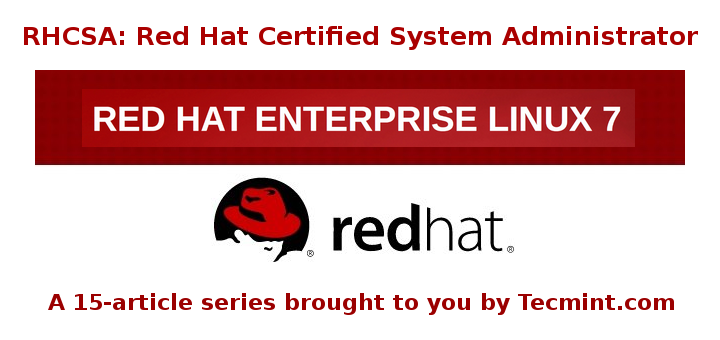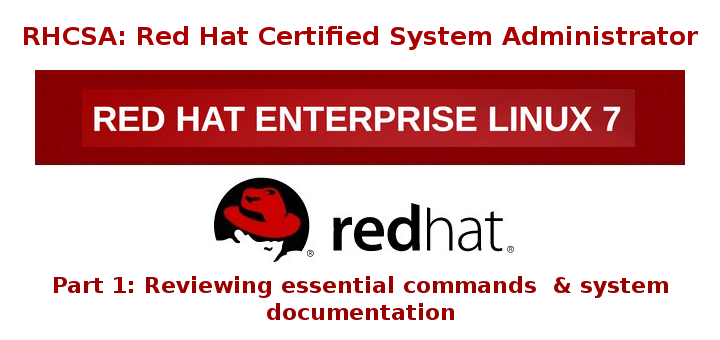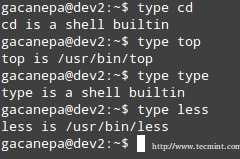RHCSA (Red Hat Certified System Administrator) is a certification exam from Red Hat company, which provides an open source operating system and software to the enterprise community, It also provides support, training and consulting services for the organizations.

RHCSA exam is the certification obtained from Red Hat Inc, after passing the exam (codename EX200). RHCSA exam is an upgrade to the RHCT (Red Hat Certified Technician) exam, and this upgrade is compulsory as the Red Hat Enterprise Linux was upgraded. The main variation between RHCT and RHCSA is that RHCT exam based on RHEL 5, whereas RHCSA certification is based on RHEL 6 and 7, the courseware of these two certifications are also vary to a certain level.
This Red Hat Certified System Administrator (RHCSA) is essential to perform the following core system administration tasks needed in Red Hat Enterprise Linux environments:
- Understand and use necessary tools for handling files, directories, command-environments line, and system-wide / packages documentation.
- Operate running systems, even in different run levels, identify and control processes, start and stop virtual machines.
- Set up local storage using partitions and logical volumes.
- Create and configure local and network file systems and its attributes (permissions, encryption, and ACLs).
- Setup, configure, and control systems, including installing, updating and removing software.
- Manage system users and groups, along with use of a centralized LDAP directory for authentication.
- Ensure system security, including basic firewall and SELinux configuration.
To view fees and register for an exam in your country, check the RHCSA Certification page.
In this 15-article RHCSA series, titled Preparation for the RHCSA (Red Hat Certified System Administrator) exam, we will going to cover the following topics on the latest releases of Red Hat Enterprise Linux 7.
In this Part 1 of the RHCSA series, we will explain how to enter and execute commands with the correct syntax in a shell prompt or terminal, and explained how to find, inspect, and use system documentation.

Prerequisites:
At least a slight degree of familiarity with basic Linux commands such as:
- cd command (change directory)
- ls command (list directory)
- cp command (copy files)
- mv command (move or rename files)
- touch command (create empty files or update the timestamp of existing ones)
- rm command (delete files)
- mkdir command (make directory)
The correct usage of some of them are anyway exemplified in this article, and you can find further information about each of them using the suggested methods in this article.
Though not strictly required to start, as we will be discussing general commands and methods for information search in a Linux system, you should try to install RHEL 7 as explained in the following article. It will make things easier down the road.
Interacting with the Linux Shell
If we log into a Linux box using a text-mode login screen, chances are we will be dropped directly into our default shell. On the other hand, if we login using a graphical user interface (GUI), we will have to open a shell manually by starting a terminal. Either way, we will be presented with the user prompt and we can start typing and executing commands (a command is executed by pressing the Enter key after we have typed it).
Commands are composed of two parts:
- the name of the command itself, and
- arguments
Certain arguments, called options (usually preceded by a hyphen), alter the behavior of the command in a particular way while other arguments specify the objects upon which the command operates.
The type command can help us identify whether another certain command is built into the shell or if it is provided by a separate package. The need to make this distinction lies in the place where we will find more information about the command. For shell built-ins we need to look in the shell’s man page, whereas for other binaries we can refer to its own man page.

In the examples above, cd and type are shell built-ins, while top and less are binaries external to the shell itself (in this case, the location of the command executable is returned by type).







Hi
Are these 15 parts enough to prepare and appear in RHEL7 EX200 exam.?
You should *NOT* assume that this series cover all you need to know to pass the RHEL 7 EX200 exam. You are highly encourage to go through the official docs by RH as well: https://access.redhat.com/documentation/en/red-hat-enterprise-linux/7/
i am getting below error plz help .
[root@centos1 ldap]# ldapadd -H ldapi:/// -f /root/ldaprootpasswd.ldif SASL/SCRAM-SHA-1 authentication started
Please enter your password:
ldap_sasl_interactive_bind_s: Invalid credentials (49)
additional info: SASL(-13): user not found: no secret in database
Please confirm if gui installed on rhcsa test machine or I have to install it using yum groupinstall gnome desktop
You should contact RH directly to answer this question, not us.
I just passed the RHCA with flying colors thanks in part to your materials.
Great work putting all this materiel up.
Thank You.
@KP – I am so glad to hear that! Congratulations!
Gabriel Cánepa,
Before of all, I want to thank you for the good work you are doing. One question is it possible you make all those topic already made to pdf?
Regards,
Fernando
@Fernando,
Actually, we are planning on putting all of these materials in PDF in the near future. Stay tuned!
YES!…..PDF’s my FAVORITE “travel document” format!…..Please hurry, I want them all for my tablet / laptop when I’m traveling!
Gabriel,
Thank you so very much for the excellent tutorial. I am assuming that you currently certified as RHCSA? I am currently preparing to go and present the text so these tutorials you have been created are excellent for practice and preparation. Gracias de nuevo!
@Jairusan,
I appreciate your taking the time to comment on this post and for your kind words about my work. To answer your question – no, I am not certified as RHCSA. More of a logistics issue than anything else – I live ~450 miles from the nearest testing center. Hopefully in the future.
Thanks. Very useful. Waiting for the next part.
@Senthilkumar, you will see Part 2 live in 2-3 days from today. Stay tuned! And thanks for following Tecmint.com.
Open the /etc/ssh/sshd.conf file and change the Port=22 entry to Port=
Restart SSh to see your new SSh port.
Make sure your firewalls are also updated for incoming requests to this new port.
HI Gabriel,
Thanks for the RHCSA tutorial, how do i get access to parts 2 onwards?
Thanks
@abdi,
Part 2 has not been published yet. I am going to submit it today so you can expect to see it live in 2-3 days.
Plzzz provide a tutorial on how to change the ssh port and listen on different port
@Gurdeep,
Please refer to another comment where @ctwhatexit answered your question.